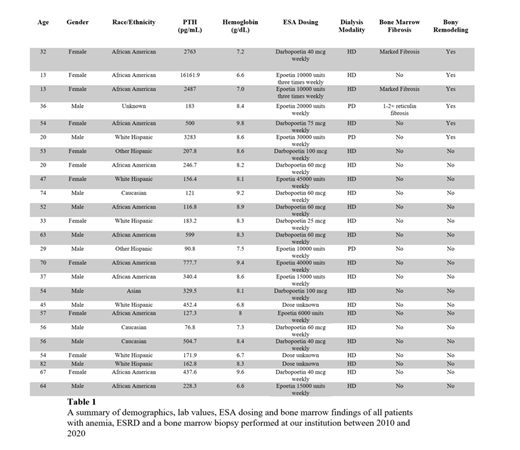Abstract
Background: Anemia is a nearly universal complication of End Stage Renal Disease (ESRD). Erythropoiesis-stimulating agents (ESAs) have greatly decreased transfusion dependence in the anemia of ESRD. In some cases, ESAs are not effective, indicating ESA-resistance. ESA-resistant anemia is not well characterized and can be difficult to manage. Among the most frequent causes of ESA-resistant anemia is secondary hyperparathyroidism (SHP), which can induce bone marrow remodeling and fibrosis. Treatment protocols in SHP are centered on goal calcium, phosphorus and parathyroid hormone (PTH) levels and not the biologic consequences of high PTH. The hematologic insults secondary to SHP are rarely addressed. Instead, it is common to simply increase ESA dosing, rather than address the cause of ESA-resistance. In this retrospective review, we describe a cohort of patients with ESRD and SHP and highlight in detail one patient with reversible bone marrow changes and transfusion-dependent anemia, as well as descriptive and laboratory findings of bone marrow changes in patients with anemia and ESRD referred to our center.
Methods: Using the EMR, the patient's data including demographics, progress notes, laboratory values, and bone marrow findings were extracted. Subsequently, the EMR was interrogated to reveal all patients with anemia and ESRD, who had undergone a bone marrow biopsy at out center over a ten year period from 2010 to 2020, revealing 64 patients. Data including demographics, laboratory values, bone marrow findings, and medications were extracted. Data was presented descriptively.
Results: A 67-year-old male with ESRD secondary to hypertension and type 2 diabetes was referred to our Hematology clinic for anemia of ESRD. He was receiving Epoetin 20,000 IU three times weekly but was still transfusion-dependent to maintain a hemoglobin of 6.3 g/dL, with a concomitant PTH of 400.5 pg/mL. Calcium and phosphorus were normal and thus his SHP was not aggressively managed. Bone marrow biopsy revealed focal areas of bone marrow remodeling and reticulin fibrosis. Fluorescence in situ hybridization studies for myelodysplastic syndrome were negative, as were thyroid studies, serum protein electrophoresis, and free light chain ratio. In conjunction with his nephrologist, treatment of his SHP was optimized. His initial regimen was calcitriol 0.25 mcg once daily and calcium acetate 667 mg three times daily. Subsequently, cinacalcet 30 mg twice daily was added and calcium acetate was replaced with sevelamer 1600 mg three times daily. Following these changes, his hemoglobin remained stable in the range of 8-9 g/dL. He was no longer transfusion-dependent, despite only a modest reduction in PTH to 311.2 pg/mL. Repeat bone marrow biopsy revealed no bone marrow remodeling or reticulin fibrosis. Bone marrow findings for all patients referred to our clinic with ESRD and anemia are summarized in Table 1. The range of PTH for patients with bony remodeling was 183-16161.9 pg/mL versus 90.8-3283 pg/mL for those without bony remodeling. The range of PTH for patients with fibrotic changes was 183-2487 pg/mL versus 90.8-16161.9 pg/mL for those without fibrotic changes. ESA dosing varied among the patients.
Conclusion: SHP is an increasingly identifiable cause of ESA-resistant anemia, as demonstrated by the reversal of transfusion dependence in our patient once SHP was more adequately treated. The degree of reversible ESA-resistant anemia and transfusion dependence in the setting of a PTH elevation to 400.5 in this case is surprising. The great variability in PTH levels of patients both with and without bone marrow changes presented here indicates the relationship between SHP and anemia is intricate. A single target level for the whole dialysis population is not appropriate; neither is targeting only and the same goal calcium, phosphorus, and PTH levels for the whole dialysis population either. Based on the findings of our institutional cohort, we suggest that it is justified to deviate from "on-size-fits-all" protocols and attempt a trial of aggressive management of SHP in patients with difficult to manage ESA-resistant anemia with what is considered only modest PTH elevation.
Moe: Allena Pharmaceutical: Consultancy; Janssen: Consultancy; Alnylum: Consultancy; DIcerna: Consultancy; Tricida: Consultancy.


This feature is available to Subscribers Only
Sign In or Create an Account Close Modal